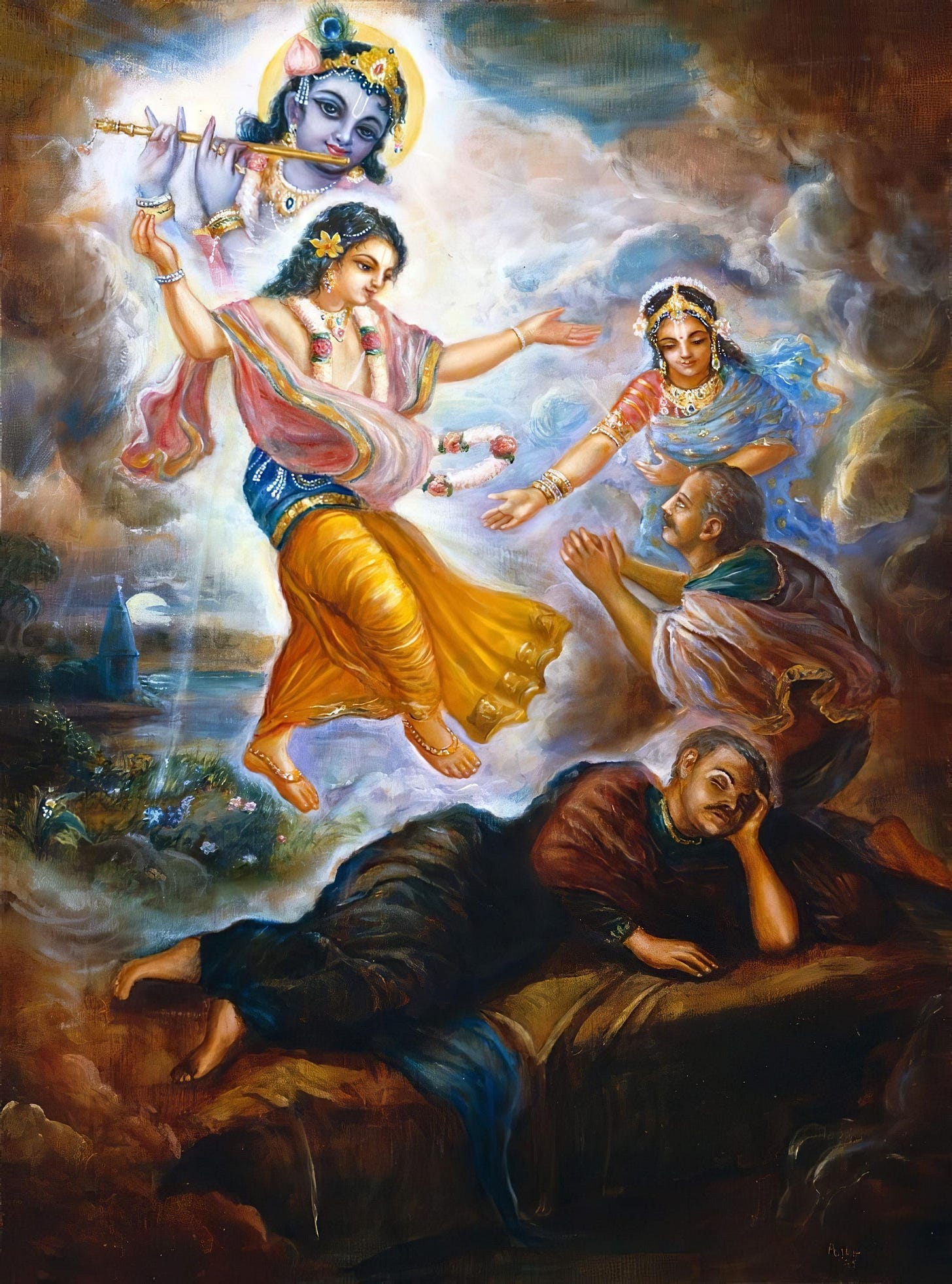Awakening from the dream
Life in this material world is often compared to a dream, not in the sense that it is not real, but in the sense that it is illusory. The question is: How to awake from this dream?
Life in this material world is often compared to a dream, not in the sense that it is not real, but in the sense that it is illusory. In a dream, we experience different situations, sometimes having a happy dream and sometimes a nightmare, all of them disconnected from our real life in the awake state.
The stage of liberation is then compared to the end of such a dream, when we can again understand our real situation and wake up to the spiritual reality, centered around our eternal relationship with Krsna.
While dreaming, a person may see different situations; he may see himself as an emperor, or in a jungle chased by a tiger, but when one awakens, he sees nothing apart from himself. Similarly, in material life, we create many illusory situations for ourselves, with growing material entanglement, but when we attain liberation by following the process of Krsna Consciousness, we see ourselves in our real position in relationship with the Lord.
This point is explained by Sanat-kumāra in the Srimad-Bhagavatam, text 4.22.27:
"When a person becomes devoid of all material desires and liberated from all material qualities, he transcends distinctions between actions executed externally and internally. At that time the difference between the soul and the Supersoul, which was existing before self-realization, is annihilated. When a dream is over, there is no longer a distinction between the dream and the dreamer."
The verse mentions that "the difference between the soul and the Supersoul, which was existing before self-realization, is annihilated" and his purport Prabhupada mentions that "a liberated person understands that he is part and parcel of the Supreme Lord acting in accordance with the desire of the Supreme Lord, and as such there is no distinction between himself and the Supreme Lord, although both of them retain their individuality (nityo nityānāṁ cetanaś cetanānām)."
This may sound like a contradiction at first, but it is nicely explained by Srila Madhvācārya in his commentary to the Māṇḍūkya Upanisad. It is similar to when we say, "in the dark everything becomes one." It doesn't mean everything merges together, but that in the dark, we don't see the distinction between the different objects. Similarly, in conditioned life, we see ourselves as separated from the Lord, which leads to an attitude of material enjoyment and illusion. In the stage of liberation, this distinction caused by the false ego disappears, and our desires become dovetailed, or connected with the Lord. Just as a mother identifies with the needs and desires of her child, we forget about any separate interest and become absorbed in the desires of Krsna. This is the true spiritual platform of oneness, different from merging in the effulgence of the brahmajyoti, which just implies becoming unconscious in the bodily effulgence of Krsna.
Another meaning of unity is that, as long as we are in an immature platform of devotional service, we sometimes practice activities connected with sense gratification and sometimes with Krsna consciousness. For a pure devotee, however, there is no such distinction, as Prabhupada explains: "When one is liberated from the material qualities, he does not do anything for his personal sense gratification. At that time all activities performed by him are absolute. In the conditioned state there are two kinds of activities: one acts on behalf of the body, and at the same time he acts to become liberated. The devotee, when he is completely free from all material desires or all material qualities, transcends the duality of action for the body and soul. Then the bodily concept of life is completely over."
This distinction between practice in the conditioned state and the liberated stage is further emphasized in the next verse:
"When the soul exists for sense gratification, he creates different desires, and for that reason he becomes subjected to designations. But when one is in the transcendental position, he is no longer interested in anything except fulfilling the desires of the Lord." (SB 4.22.28)
The main difference between a liberated soul and a conditioned soul is that a conditioned soul lives under the material designations created by the false ego, identifying with the body and mind. False ego means to think I'm something I'm not. If I were to start thinking I'm a dog, suddenly my needs would be very different from what they are now. Similarly, as a spirit soul, my needs are connected with the service of the Lord, and I find perfect satisfaction in this activity, but as soon as I think I'm a man, a woman, or anything else, my needs become different, and I start to act in ways that are contradictory to my real interest.
This is accompanied by many material desires that make us absorbed in matter. Even when we start our spiritual practice, this identification with matter persists to a certain degree, and in this way, we see a difference between matter (what we use for our sense gratification) and spirit (what we see as connected with Krsna). For a pure devotee, however, there is no matter; he sees everything as connected with Krsna and is ready to use everything and anything in His service. In this platform, there is not even need to renounce anything, because he doesn't see anything as his possession. He sees Krsna in everything and everything in Krsna. This is yet another meaning of oneness.
In his purport, Prabhupada describes this vision in detail:
"The liberated person has no attachment for anything material or for sense gratification. He understands that everything is connected with the Supreme Personality of Godhead and that everything should be engaged in the service of the Lord. Therefore he does not give up anything. There is no question of renouncing anything because the paramahaṁsa knows how to engage everything in the service of the Lord. Originally everything is spiritual; nothing is material. In the Caitanya-caritāmṛta (Madhya 8.274) also it is explained that a mahā-bhāgavata, a highly advanced devotee, has no material vision:
sthāvara-jaṅgama dekhe, nā dekhe tāra mūrti
sarvatra haya nija iṣṭa-deva-sphūrtiAlthough he sees trees, mountains, and other living entities moving here and there, he sees all as the creation of the Supreme Lord and, with reference to the context, sees only the creator and not the created. In other words, he no longer distinguishes between the created and the creator. He sees only the Supreme Personality of Godhead in everything. He sees Kṛṣṇa in everything and everything in Kṛṣṇa. This is oneness."
One more meaning of oneness is to not make a distinction between oneself and others, based on the idea that we are all spirit souls, parts and parcels of Krsna, in a spirit of true brotherhood. As defined by Madhvācārya, one soul is distinct from another in the sense that we are different individuals, but at the same time we are equal in nature. This is emphasized by Sanat-kumāra in text 29:
"Only because of different causes does a person see a difference between himself and others, just as one sees the reflection of a body appearing differently manifested on water, on oil or in a mirror." (SB 4.22.29)
What does this example mean? The same person appears different when reflected in different surfaces. Because the water moves, the reflection appears to move. While reflected in a mirror, the reflection becomes stable. Reflected on oil, it appears hazy, and so on. Similarly, the soul acquires different varieties of forms and activities due to contact with the three modes, accepting different upādhis, or designations. This, however, doesn't change the actual position of the soul. In the Gītā (18.21), Krsna explains that knowledge by which one sees that in every different body there is a different type of living is in the mode of passion. A learned person does not discriminate based on the body (5.18).
In this way, Sanat-kumāra, Madhvācārya, and Srila Prabhupada cooperate in giving us knowledge that can make us free from this material world.
Read also:
How does the soul come to the material world? Sanat-kumāra's answer (Srimad Bhagavatam #61)
Sanat-kumāra makes the analogy of a lake drying up because of kuśa grass growing on its banks. If the grass is allowed to grow freely, it sucks the water until the lake completely dries up. In the same way, if material desires are allowed to grow, they progressively cover the original Krsna consciousness of the soul, up to the point where one can become a dog or a pig. Therefore, these columns of kuśa grass that are drying up our consciousness should be cut down from the beginning. We should understand the danger of unrestricted sense gratification and where it can lead us.
If you read this article to the end, give it a like. This makes Substack recommend it to more people.




Chaitanya Chandra Das Ki Jai
A.C. Bhaktivedanta Swami SriIa Prabhupada Ki Jai
AII GIories To The Lord_Devotees ReUnited
Jai Sri Hari
Hare Rama Hare Krsna
Jai Srimati Radharani Jai Sittttaah Raam Jai Arjuna Jai Hanuman Jai Lakshmana Hari Hari Hari Hari HariboI; AII Glories To Lord Achyuta KESHAVA Ajam Vibhum,
Hare Krishna Prabhu ji 🙏 nicely elaborated this article in a systematic manner .